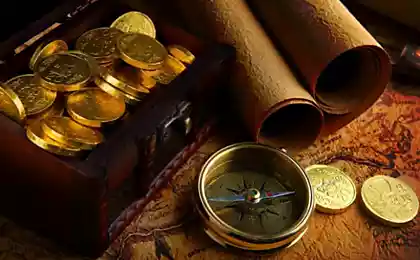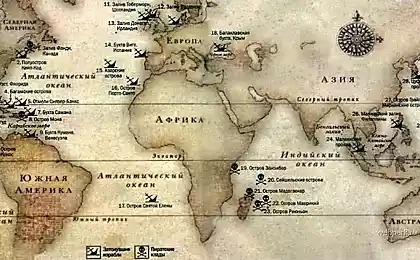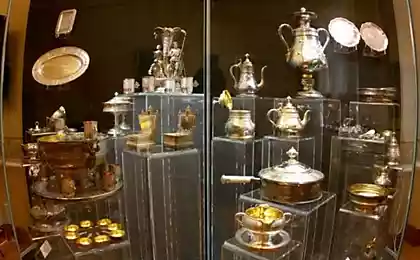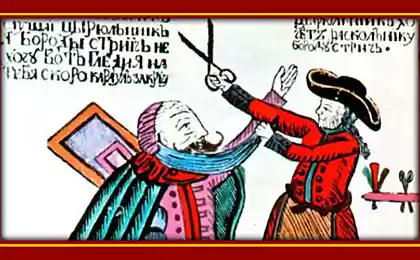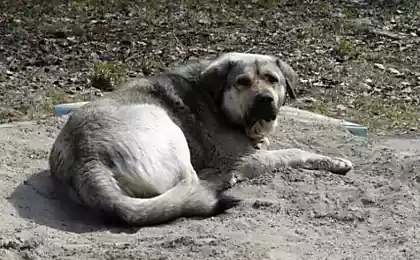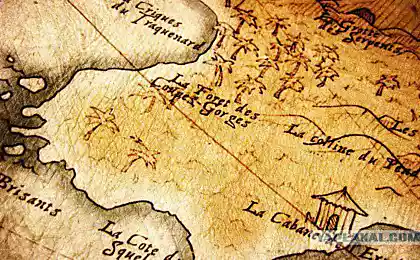1646
Collection of Peter I (16 photos)
Take a look at the ancient treasures of the Siberian collection of Peter I.
Very valuable, probably worth a fortune.
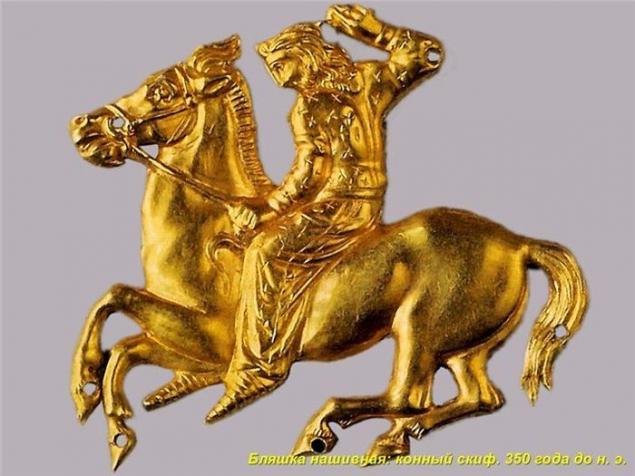
In 1715 Ural gornozavodchikov Nikita Demidov sent a gift to Catherine I («by heart» the newborn prince) of 100 thousand rubles in gold and some gold objects from the Siberian burial mounds. These things were found bugrovschikami - people who hunted the search for ancient burial mounds and pulled out value. Many merchants in Siberia and the Urals bought extracted in this way the treasure and melted them, profiting from sales of gold.
Peter I decided to put an end to this and issued a decree ordering all the interesting and unusual finds donate authorities. Soon Prince MP Gagarin, the governor of Siberia, sent to St. Petersburg a lot of old gold items that formed the basis of the first and the world's only collection of Siberian gold items. First, the collection was stored in the cabinet of curiosities of Peter, and in 1859 transferred to the Hermitage. Since this year was established the Imperial Archaeological Commission, which was tasked with collecting information on ancient monuments and antiquities search, related primarily to the country's history and life of the peoples inhabiting the vast expanses of Russia.
Over time, the collection has grown, and its constituent exhibits geographically gone far beyond just one Siberian burial mounds. Now it is, and the world famous "Scythian gold».
... Broad band from the Danube to the Yenisei River (and further in the Trans-Baikal and Mongolia) runs a huge steppe, cut into pieces deep rivers. For a long time on these boundless as the sea, open spaces settled kindred peoples, unhampered by barriers. There bloomed homogeneous culture and created vast empires, often not very durable. Here lies the devastating path of conquest and the Great Migration.
Steppe, as the sea is rarely calm: the one in its place, then climbed another storms that often drifts barrows (earthen mounds) - these characteristics of the Eurasian landscape. Mounds stretched in all directions of the horizon, wherever you looked. Some of them barely rise above the steppe, while others raised hemispherical or conical mountain. Often these mountains reach a height of 20-25 meters and hundreds of meters in circumference.
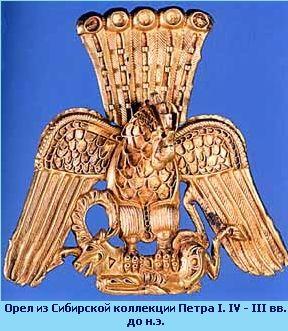
Especially large size and complexity of the devices differ burial mounds with burials of Scythian leaders. The vast majority of Scythian burial mounds were plundered even their contemporaries, but not only ... So, for example, the rich Kelermesskaya mounds were excavated in 1903 no expert, but one hunter - a kind of technician DG Shultz. He dug in four nerazgrablennye Kuban embankment, which found a lot of expensive things - hats and weapons buried.
Although Kelermesskaya mounds were plundered, then, scientists have found here a great silver mirror decorated with engraved on the back side, and overlaid with a thin gold leaf, which stamped the wonderful drawings.
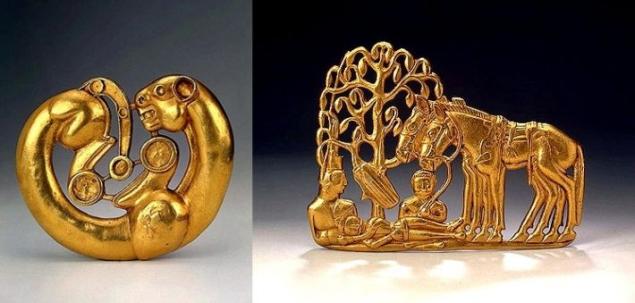
The back side of the mirror is divided radii of rope into eight sectors, sharp corners are filled with two petals. In the center of the mirror the petals form a large rosette, and the remainder of each sector is filled with images of animals and mythological subjects, and those and others alternate between them in the correct order. For example, in one of the sectors in full growth in a long (up to Fr) clothes represented Cybele - the winged goddess of the eastern, mistress of the animals. She holds the front legs of the two lions, cowardly push-tails. In the neighboring sector depicts a bull fight with a lion and a boar figure of this scene.
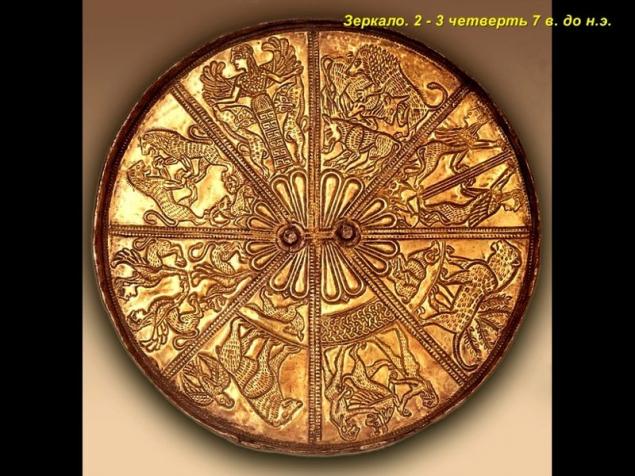
One of the most interesting exhibits of the collection are the Scythian objects found in the 1862-1863 years Chertomlyk mound (to the north of the town of Nikopol), and among them a magnificent golden lights - quiver and bow case for the same time. Did it burn Greek goldsmith, he also decorated it with reliefs depicting scenes from ancient mythology. The two levels, for example, there are scenes depicting the life and exploits of Achilles - from the time when his child taught archery to the last episode - when his mother, the goddess Thetis, clutching an urn with the ashes of the deceased son mourns it.
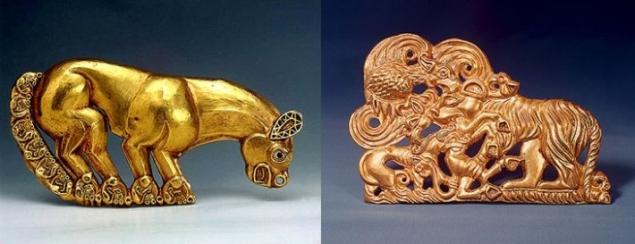
The large size of the gold plates is lit beautifully executed chased reliefs seemingly say that this precious thing can exist only in a single copy. But more recent discoveries have allowed scientists to suggest that the goldsmith at some of the Greek colonies of the Black Sea has produced one form of multiple lit and sent them to their customers (the Scythian kings) in different places.
The ancient Greeks sang and the world-famous golden comb from the mound Solokha - one of the rare neograblennyh Scythian burial. It was a huge mound height of 18 meters, consists of two burial. The central tomb was a rectangular pit with two chambers, dug in its long sides.
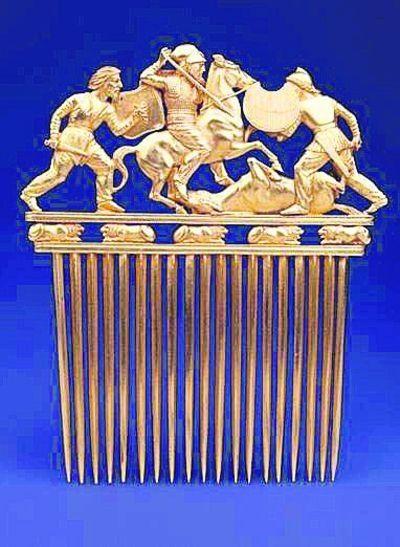
Found in a mound ridge refers to the line V-IV centuries BC - the heyday of ancient Greek art. The creators of the ridge into account the tastes of the customers, as they were familiar with the culture of the Scythians. The upper part of the ridge is made in the form of a sculptural group depicting the battle between the Scythians. It captured the decisive moment the fight, when the rider and the pedestrian collided with the enemy, just lost his horse. Image details worked out so subtly that see every strand of hair on the head of one of the soldiers, the shell segments rider, plaques sewn on clothes, jewelry, and the wound is leaking out of her blood on his neck fallen horse.
Due to accurately calculate the distance between the figures of the ancient masters achieved compositional unity, harmony and balance volumetric mass. Two horizontal bars sandwiched between five lions figures are the basis for the main sculptural group and create a transition to the teeth of the comb.
Very characteristic depicted on the crest of a horse - small, with long tails and manes cropped. Rider sharply reined in his horse, and he stood on his hind legs, and a wounded horse lying on your back with bent legs raised.
And in 1853, during excavations near Feodosia were found on the unique craftsmanship earrings. They showed to the world samples of peculiar species of ancient Greek art, which is called microtechnology. Each earring consists of a richly ornamented disc, the edges of which are covered with several rows of corn. On the inner surface of the disks housed eight elegant palmettos with rosettes at the base and the center of the flower is decorated with lush multileaf.
The main decoration of each earring - multi-figure composition, made in microscopic forms. Here is a widespread view in Athens sports. At full speed rush four horse-drawn chariot, which controls the winged goddess Nike. To her right is a warrior with a large shield, is about ready to jump out of the chariot, to the very end the run to the finish tape.
Ancient Master performed on earrings and details such as the pattern on the shield of the hero-warrior, and even a feather on each wing of the goddess. In "Feodosiya earrings" granulation so small that it is impossible to see without a magnifying glass. Only at high magnification it shows that tiny grains are connected and arranged on four rows. Such trim parts and created a worldwide fame "Feodosia earrings", especially as invented by the ancient Greek masters granulation technique has since been lost.
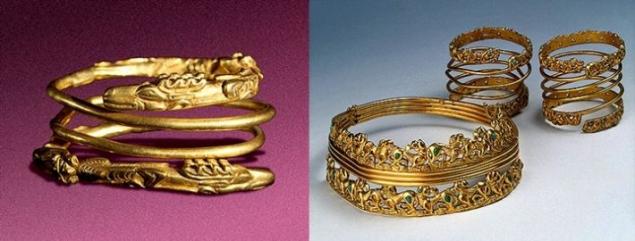
Not surprisingly, after Theodosia finds these earrings immediately attracted the attention of goldsmiths. Many jewelers Petersburg and Paris tried to make a copy of jewelry, but the task proved impossible because of ignorance of the soldering method and composition of the solder that was used ancient masters. Even the famous Carl Faberge, who tried to repeat the "Feodosia earrings" failed. He could not perform lunnitsu, completely covered with grain. The tiny, barely visible to the naked eye the golden balls in ancient monuments were evenly distributed over the entire surface. When you create a copy of Faberge was not possible to connect even three seed - they merged and kept on earrings. But he used the achievements of contemporary art, in particular, the optics, which had ancient masters. Later, after much effort jewelers managed to connect only three instead of four grain and grain ancient technique exists to this day remains unknown.
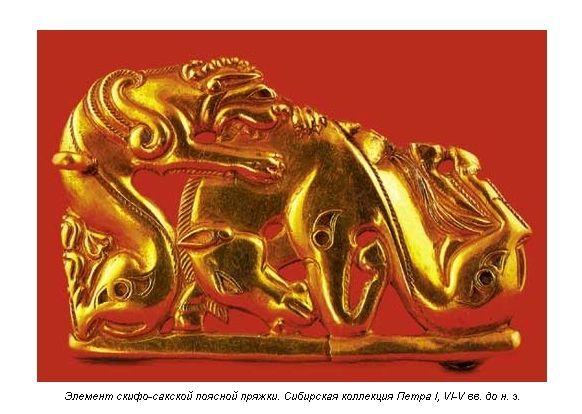
Notes
1. The common name "Scythians" in science is called the population of the Eurasian steppes, which lived from the Danube to the Yenisei in the VII-III centuries BC. And it consisted of many kindred tribes who had their own names.
2. In the Vinnytsia region, and then in the region of Melitopol and near Rostov archaeologists found exactly it shine.
Scythian gold from different collections
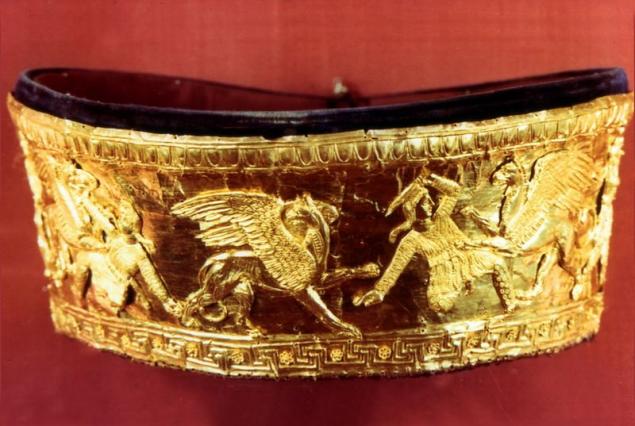
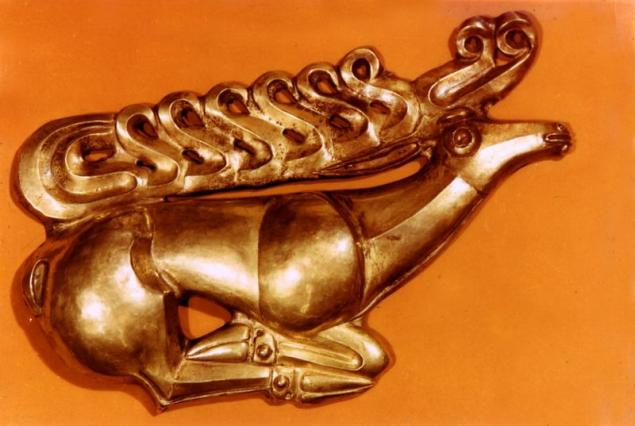
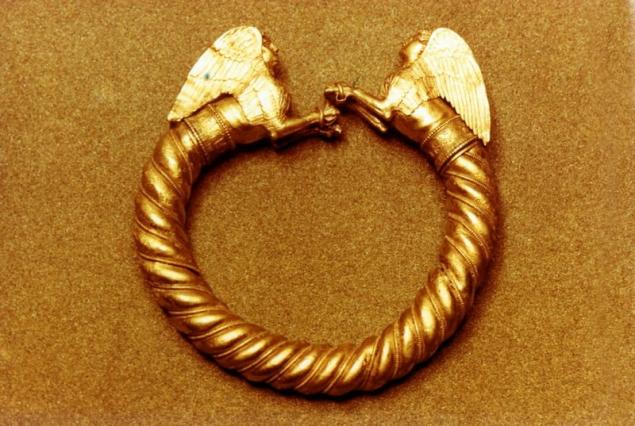
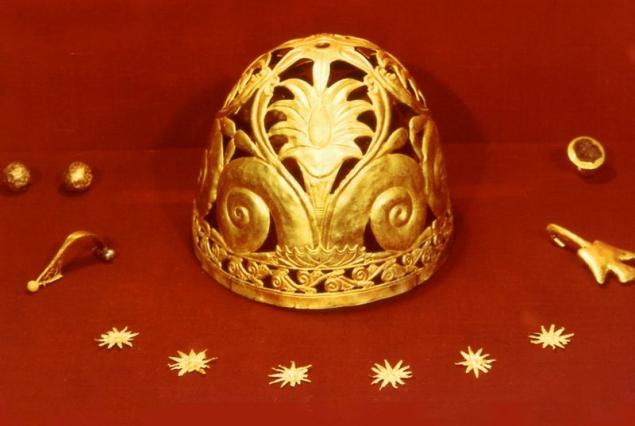
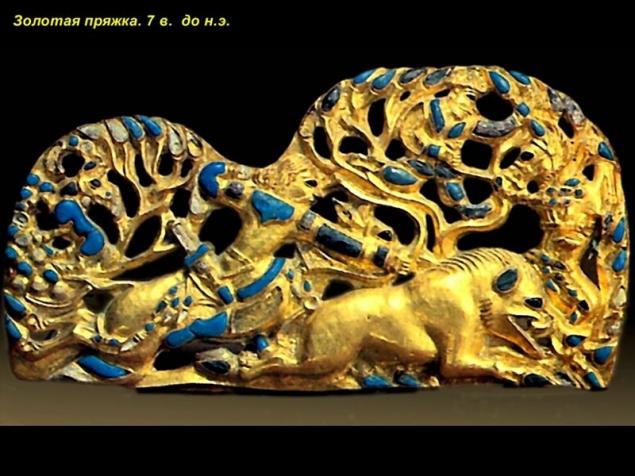
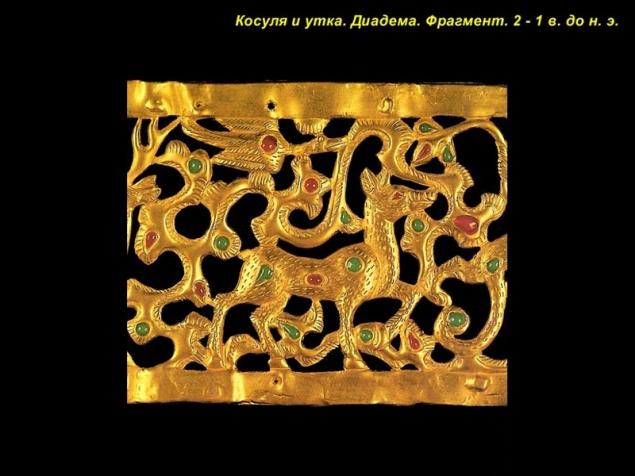
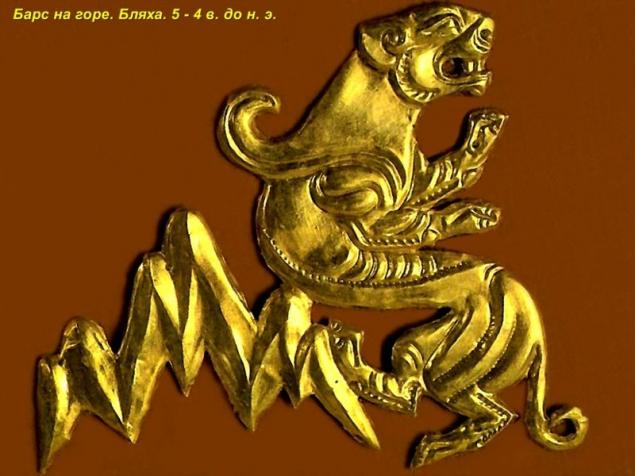
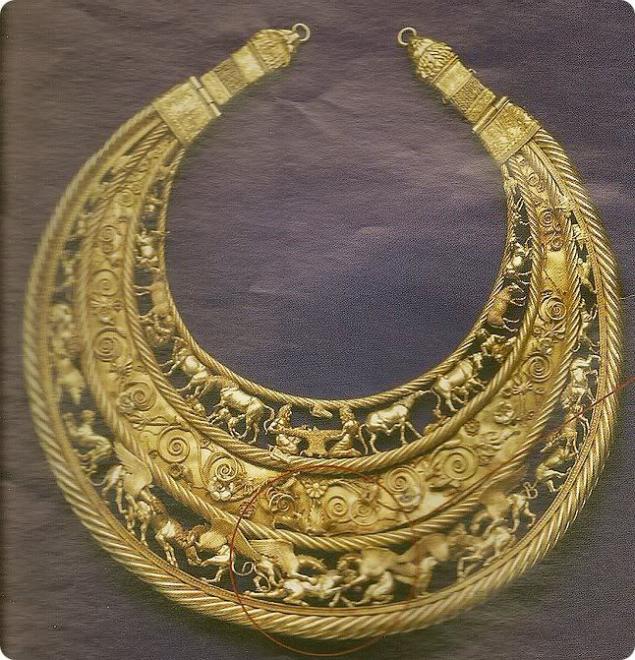
Pectoral - male pectoral ornament, IV century BC
Source: vsiaco.org.ua
Very valuable, probably worth a fortune.

In 1715 Ural gornozavodchikov Nikita Demidov sent a gift to Catherine I («by heart» the newborn prince) of 100 thousand rubles in gold and some gold objects from the Siberian burial mounds. These things were found bugrovschikami - people who hunted the search for ancient burial mounds and pulled out value. Many merchants in Siberia and the Urals bought extracted in this way the treasure and melted them, profiting from sales of gold.
Peter I decided to put an end to this and issued a decree ordering all the interesting and unusual finds donate authorities. Soon Prince MP Gagarin, the governor of Siberia, sent to St. Petersburg a lot of old gold items that formed the basis of the first and the world's only collection of Siberian gold items. First, the collection was stored in the cabinet of curiosities of Peter, and in 1859 transferred to the Hermitage. Since this year was established the Imperial Archaeological Commission, which was tasked with collecting information on ancient monuments and antiquities search, related primarily to the country's history and life of the peoples inhabiting the vast expanses of Russia.
Over time, the collection has grown, and its constituent exhibits geographically gone far beyond just one Siberian burial mounds. Now it is, and the world famous "Scythian gold».
... Broad band from the Danube to the Yenisei River (and further in the Trans-Baikal and Mongolia) runs a huge steppe, cut into pieces deep rivers. For a long time on these boundless as the sea, open spaces settled kindred peoples, unhampered by barriers. There bloomed homogeneous culture and created vast empires, often not very durable. Here lies the devastating path of conquest and the Great Migration.
Steppe, as the sea is rarely calm: the one in its place, then climbed another storms that often drifts barrows (earthen mounds) - these characteristics of the Eurasian landscape. Mounds stretched in all directions of the horizon, wherever you looked. Some of them barely rise above the steppe, while others raised hemispherical or conical mountain. Often these mountains reach a height of 20-25 meters and hundreds of meters in circumference.

Especially large size and complexity of the devices differ burial mounds with burials of Scythian leaders. The vast majority of Scythian burial mounds were plundered even their contemporaries, but not only ... So, for example, the rich Kelermesskaya mounds were excavated in 1903 no expert, but one hunter - a kind of technician DG Shultz. He dug in four nerazgrablennye Kuban embankment, which found a lot of expensive things - hats and weapons buried.
Although Kelermesskaya mounds were plundered, then, scientists have found here a great silver mirror decorated with engraved on the back side, and overlaid with a thin gold leaf, which stamped the wonderful drawings.

The back side of the mirror is divided radii of rope into eight sectors, sharp corners are filled with two petals. In the center of the mirror the petals form a large rosette, and the remainder of each sector is filled with images of animals and mythological subjects, and those and others alternate between them in the correct order. For example, in one of the sectors in full growth in a long (up to Fr) clothes represented Cybele - the winged goddess of the eastern, mistress of the animals. She holds the front legs of the two lions, cowardly push-tails. In the neighboring sector depicts a bull fight with a lion and a boar figure of this scene.

One of the most interesting exhibits of the collection are the Scythian objects found in the 1862-1863 years Chertomlyk mound (to the north of the town of Nikopol), and among them a magnificent golden lights - quiver and bow case for the same time. Did it burn Greek goldsmith, he also decorated it with reliefs depicting scenes from ancient mythology. The two levels, for example, there are scenes depicting the life and exploits of Achilles - from the time when his child taught archery to the last episode - when his mother, the goddess Thetis, clutching an urn with the ashes of the deceased son mourns it.

The large size of the gold plates is lit beautifully executed chased reliefs seemingly say that this precious thing can exist only in a single copy. But more recent discoveries have allowed scientists to suggest that the goldsmith at some of the Greek colonies of the Black Sea has produced one form of multiple lit and sent them to their customers (the Scythian kings) in different places.
The ancient Greeks sang and the world-famous golden comb from the mound Solokha - one of the rare neograblennyh Scythian burial. It was a huge mound height of 18 meters, consists of two burial. The central tomb was a rectangular pit with two chambers, dug in its long sides.

Found in a mound ridge refers to the line V-IV centuries BC - the heyday of ancient Greek art. The creators of the ridge into account the tastes of the customers, as they were familiar with the culture of the Scythians. The upper part of the ridge is made in the form of a sculptural group depicting the battle between the Scythians. It captured the decisive moment the fight, when the rider and the pedestrian collided with the enemy, just lost his horse. Image details worked out so subtly that see every strand of hair on the head of one of the soldiers, the shell segments rider, plaques sewn on clothes, jewelry, and the wound is leaking out of her blood on his neck fallen horse.
Due to accurately calculate the distance between the figures of the ancient masters achieved compositional unity, harmony and balance volumetric mass. Two horizontal bars sandwiched between five lions figures are the basis for the main sculptural group and create a transition to the teeth of the comb.
Very characteristic depicted on the crest of a horse - small, with long tails and manes cropped. Rider sharply reined in his horse, and he stood on his hind legs, and a wounded horse lying on your back with bent legs raised.
And in 1853, during excavations near Feodosia were found on the unique craftsmanship earrings. They showed to the world samples of peculiar species of ancient Greek art, which is called microtechnology. Each earring consists of a richly ornamented disc, the edges of which are covered with several rows of corn. On the inner surface of the disks housed eight elegant palmettos with rosettes at the base and the center of the flower is decorated with lush multileaf.
The main decoration of each earring - multi-figure composition, made in microscopic forms. Here is a widespread view in Athens sports. At full speed rush four horse-drawn chariot, which controls the winged goddess Nike. To her right is a warrior with a large shield, is about ready to jump out of the chariot, to the very end the run to the finish tape.
Ancient Master performed on earrings and details such as the pattern on the shield of the hero-warrior, and even a feather on each wing of the goddess. In "Feodosiya earrings" granulation so small that it is impossible to see without a magnifying glass. Only at high magnification it shows that tiny grains are connected and arranged on four rows. Such trim parts and created a worldwide fame "Feodosia earrings", especially as invented by the ancient Greek masters granulation technique has since been lost.

Not surprisingly, after Theodosia finds these earrings immediately attracted the attention of goldsmiths. Many jewelers Petersburg and Paris tried to make a copy of jewelry, but the task proved impossible because of ignorance of the soldering method and composition of the solder that was used ancient masters. Even the famous Carl Faberge, who tried to repeat the "Feodosia earrings" failed. He could not perform lunnitsu, completely covered with grain. The tiny, barely visible to the naked eye the golden balls in ancient monuments were evenly distributed over the entire surface. When you create a copy of Faberge was not possible to connect even three seed - they merged and kept on earrings. But he used the achievements of contemporary art, in particular, the optics, which had ancient masters. Later, after much effort jewelers managed to connect only three instead of four grain and grain ancient technique exists to this day remains unknown.

Notes
1. The common name "Scythians" in science is called the population of the Eurasian steppes, which lived from the Danube to the Yenisei in the VII-III centuries BC. And it consisted of many kindred tribes who had their own names.
2. In the Vinnytsia region, and then in the region of Melitopol and near Rostov archaeologists found exactly it shine.
Scythian gold from different collections








Pectoral - male pectoral ornament, IV century BC
Source: vsiaco.org.ua

